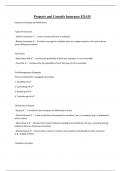Property and Casualty Insurance EXAM
Insurance Concepts and Definitions
Types of Insurance
- Specific Insurance ✔️: Covers a particular item or property.
- Blanket Insurance ✔️: Provides coverage for multiple items at a single location or for several items
across different locations.
Risk Types
- Speculative Risk ✔️: Involves the possibility of both loss and gain; it is non-insurable.
- Pure Risk ✔️: Involves only the possibility of loss; this type of risk is insurable.
Risk Management Strategies
The five methods for managing risk include:
1. Avoiding risk ✔️
2. Controlling risk ✔️
3. Retaining risk ✔️
4. Transferring risk ✔️
Definitions of Hazard
- Hazard ✔️: A condition that increases the likelihood of a loss.
- Physical Hazard ✔️: A risk arising from the property’s condition, use, or occupancy (e.g., a skateboard
left on stairs).
- Moral Hazard ✔️: Results from careless behavior leading to increased loss risk (e.g., someone driving
recklessly because they have insurance).
- Morale Hazard ✔️: Occurs when a person creates a loss situation intentionally to claim insurance
(e.g., staging a theft).
Valuation Concepts
,- Replacement Cost ✔️: The cost to replace an item with a similar one at the time of loss, without
depreciation deductions.
- Actual Cash Value (ACV) ✔️: Calculated as replacement cost minus depreciation.
- Pair and Set Clause ✔️: Protects against loss of an individual item in a pair or set.
- Appraisal ✔️: A resolution method for disputes regarding loss amounts, involving appraisers and an
umpire if necessary.
- Subrogation ✔️: The insurer's right to reclaim losses paid to the insured from the party responsible for
the loss.
- Arbitration ✔️: A broader dispute resolution process that can address various disagreements beyond
just the valuation of a loss.
Insurance Coverage Terms
- WC SHAVVER ✔️: Acronym denoting covered perils: Windstorm, Civil commotion, Smoke, Hail,
Aircraft, Vehicles, Volcanic eruption, Explosion, Riot.
- BIG AFFECT ✔️: Covers specific types of property damage: Burglar damage, Ice & snow weight, Glass
breakage, Accidental discharge, Falling objects, Freezing of pipes, Electrical damage, Collapse, Tearing
apart.
Financial Terms
- Insolvency ✔️: A situation where liabilities exceed assets.
- Law of Agency ✔️: The concept that an agent’s knowledge is considered the principal's knowledge
(the insurance company).
Insurance Services
- ISO (Insurance Services Office) ✔️: An organization that supports member insurance companies with
statistical data, policy forms, loss costs, and inspections for rate-making.
Insurance Clauses and Conditions
- Coinsurance Clause ✔️: Requires the insured to maintain a minimum amount (typically 80%) of the
property's replacement cost to ensure full payment for partial losses.
- Estoppel ✔️: Prevents changing or denying a fact based on previously established actions or
statements.
,- Binder ✔️: A temporary insurance agreement, either verbal or written, valid for 30-60 days until a
formal policy is issued or denied.
- Warranty ✔️: A guarantee within a policy that a condition exists or will exist in the future.
Claim Processing
- Deposit Premium ✔️: An initial charge made for certain policies that is later adjusted based on actual
earned amounts.
- Audit ✔️: A verification of financial records for accuracy.
- Occurrence ✔️: An event that results in injury or property damage, including continuous exposure to
harmful conditions.
Types of Damages
- Special Damages ✔️: Compensatory damages for specific direct expenses, such as medical bills and
lost wages.
- General Damages ✔️: Compensates for non-specific losses like pain, suffering, and emotional distress.
- Punitive Damages ✔️: Monetary penalties designed to punish wrongful behavior and deter similar
actions in the future.
- Proximate Cause ✔️: The act that is directly responsible for a loss due to an uninterrupted chain of
events.
Elements of Negligence
The four elements necessary to establish negligence are:
1. The existence of a duty to act in a certain way ✔️.
2. A failure to fulfill that duty ✔️.
3. An actual injury resulting from the failure ✔️.
4. The failure must be the proximate cause of the injury ✔️.
Insurance Fundamentals
- Negligence ✔️: A failure to act with reasonable care, which can lead to unintentional harm.
, - Casualty Insurance ✔️: Protects against liabilities arising from negligence in professional, business, or
personal contexts.
- Overinsurance ✔️: Occurs when property is insured for more than its fair value, leading to multiple
policies on the same property.
Coverage Types for Vehicles
- Uninsured Motor Vehicle ✔️: Defined as any vehicle with no liability coverage at the time of an
accident, inadequate coverage based on state requirements, operated by a hit-and-run driver, or where
the insurer is insolvent.
- Part C: Uninsured Motorist Coverage ✔️: Compensates the insured for bodily injuries due to accidents
with uninsured motorists.
- Medical Payments ✔️: Covers necessary medical and funeral expenses for injuries from an accident,
applicable to first-party claims with a 3-year limit.
- Supplementary Payments ✔️: Additional payments for loss of earnings and bail costs resulting from
an accident.
- Excess Coverage ✔️: Refers to insurance on vehicles not owned by the insured that applies after any
primary coverage.
Coverage Limits
- Single Limit Basis ✔️: A single total limit that covers all claims from one accident, irrespective of
claims' nature (Bodily Injury and Property Damage combined).
- Split Limit Basis ✔️: Separate limits for bodily injury and property damage in a defined format (e.g.,
20/50/10).
- Combined Single Limit ✔️: A single limit covering both bodily injury and property damage.
Coverage Types in Auto Insurance
- Part A - Liability Coverage ✔️: Covers payments for bodily injury and property damage for which the
insured is legally responsible, encompassing both special and general damages.
- Loss of Use ✔️: Refers to an individual's inconvenience caused by not being able to use their property.
- Underinsured Motorist Coverage (UIM) ✔️: Provides coverage when the insured's damages exceed
the limits of the at-fault driver's liability insurance.
- Collision ✔️: Coverage for damage resulting from a vehicle's impact or overturning.




